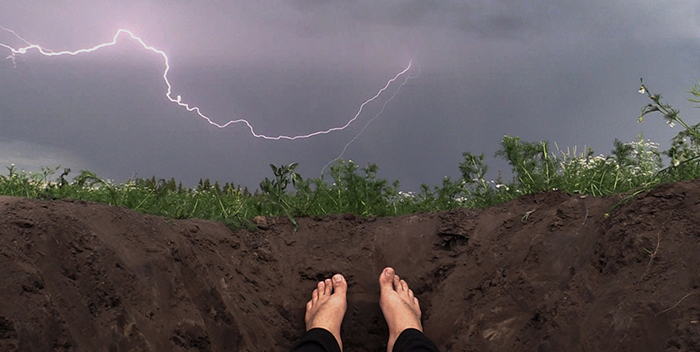
MFA Artist Kyle Terrence talks end times in his drawing and intermedia final presentation
You don’t normally associate an art gallery visit with being faced with apocalyptic fears. But if you visit FAB Gallery before February 13th, you will have the chance to not only face those fears but to be taken by the hand on a journey of exploration of them.
Kyle’s work winds you through this exploration in a dream-like Pilgrimage of a world touched by, but seemingly devoid of humans. The low, menacing soundtrack to his film, Pilgrimage, immediately sets the scene with it’s dark foreshadowing.
His tall triptychs have a similar effect with their vast spaces occupied conspicuously by a strange bipedal creature and filled with menacing clouds. The creature, created with a fur costume and mask hailing back to the doctors of the black plague, haunts the landscapes in its inexorable journey.
I came away rethinking our impact, as humans, on the environment, along with my own place within these times of ecological crisis. On my commute home, the radio host’s jaunty commentary on our warm winter was tainted by my resultant eschatological musings.
I spoke with Kyle and asked him some follow-up questions about the exhibit and his work.
For those who don’t know, can you give us a brief summary of who you are?
I am an artist from Edmonton, Alberta. I recently completed a Master of Fine Arts at the University of Alberta, and this show is a presentation of the visual exhibition portion of my thesis work.
Can you tell us a bit about the work you have in this exhibition?
Pilgrimage: being in the end times is an exhibition built for a specific way of seeing in the Anthropocene (the term for our new geological epoch generated by human activity). Like bifocal vision, this work attempts to bring together two disparate focal planes: the kitsch and the sublime. The work is really just a contemplation on my own apathy with, and detachment from, both the ecological crisis and the materiality of the world in general.

Can you tell me a bit more about the inspiration behind the work
The impetus of the project was a dissatisfaction I felt with popular representations of the apocalypse. This genre is currently proliferating, however, the tropes and iconography used have never made sense to me. Unlike previously imagined or endured apocalypses (nuclear exchange, the biblical rapture, etc) the ecological crisis is not characterized by a pinnacle moment of violence. Its scale is massively distributed across both time and space, and that’s why we talk about it in terms of geological time. The narratives I am confronted with in popular culture still use the apocalyptic model of explosive violence and often take place in derelict future dystopias. If I am indeed living in the Anthropocene, and more specifically the 21st century, this type of imagery for me is not relatable. Instead, I see the ecological and social clockwork running efficiently against a familiar and banal background. In spite of climate change, unprecedented weather events, and the like, I see suburban sprawl, row housing, and even beautiful sunsets at dusk. As harrowing a concept as the Anthropocene is, for me this banality captures what it really looks like to be living in this time.
What is the symbolism behind the suit and mask you wear?
The mask was a nod to the kinship I feel with the naïve 14th century physicians of Black Death, the plague doctors. It was also a way for me to embrace some of the kitsch that surrounds the depictions of each apocalypse. I designed the mammalian suit as kind of a knee-jerk reaction to the solemnity of this topic. Many people seem really interested in carving out a nature-culture divide so that they can work to find some way to reconnect with “nature”. The fur was kind of a funny way for me as an artist to both acknowledge and refute that sentiment.

Can you tell me about the technical side of things? How long did it take to gather footage and edit the final version of Pilgrimage?
I had been working with similar ideas and experiments for about a year, but this particular body of work took me the last eight months of my thesis to make. Like any project it involved balancing planned ideas with fortuitous experiences. Most of the principal photography happened in the summer months, and I spent the fall finishing the photos and film in post-production as well as assembling the triptych.
There is some religious connotation (Book of Revelations) in your work. Was this intentional? If it was can you tell me a bit about that side of your exploration?
I am always vigilant to describe the work as secular to avoid misinterpretations considering the aesthetic used. The majority of the exhibition is pulling its aesthetic from Abrahamic theology. Religion in general has a rich history of apocalyptic discourse, and because I am thinking about the apocalypse, I wanted to borrow from the language that has already been developed for millennia. The triptych, for example, was a great format for me to create multiple landscapes that could be simultaneously inhabited by the viewer. Theological aesthetics is another part of apocalyptic discourse that embraces kitsch (pillars of fire, clouds parting, beams of light, etc.), and for me, I liked projecting that type of melodrama onto such familiar or picturesque imagery.
Your work left me feeling unsettled (in a great way). Listening to the radio this morning with the hosts talking about how great the warm weather is, with no talk about climate change made me immediately think back to your work. What do you hope viewers will take away from viewing your exhibit?
I think that being unsettled is a great response. I am not interested in sending a message or making activist art, but I don’t mean to free myself from conceptual responsibility. I think the role of an artist parallels the curious and inquisitive nature of a child. They are both great at pointing at things that you may have otherwise stepped on or walked past. In this particular case, that means contemplating what it means to be living in a time where you are told that your species has doomed itself through the development of a vast and voracious economic system and infrastructure, and that there probably isn’t a way out of it. I have tried to create various lenses to look at the everyday around us while thinking about the crisis. I think in some ways apathy or melancholy is a more valid response to the ecological crisis than misguided optimism.

What are your plans now that you are finishing up your MFA work?
I have a bunch of projects, probably too many, bubbling up to the surface at the moment. It’s exciting to be able to make some work that is perhaps less academically responsible than I am used too. I am working out the logistics of a film, a performance piece, and a quasi-documentary at the moment. Some of this work should be released during the summer.
What advice would you give other artists who are just starting their education, or just starting their careers?
Considering I’m fresh out of the gates, I’m not sure I’m in any position to be giving this kind of advice yet. Being involved in art academia, teaching, as well as working in various artist-run centers for the last eight years, I have noticed an important distinction potential artists need to consider within themselves. Skill, craft, intellect, and the ability to think through visual literacies are all great (and probably necessary) attributes to have as an artist. But the driving force should be the compulsion to create things in response to the stimuli that you are confronted by. It sounds romantic, but really it’s just the traditional definition of creative, meaning: ‘to make’ as opposed to the now ubiquitously used neoliberal definition meaning ‘innovative’ or ‘thinking outside the box.’ If you find yourself constantly driven to make things then you are probably working in this field for the right reasons.
Presenter: FAB Gallery
Event Title:Pilgrimage: being in the end times
Dates: until Feb. 13 2016
Venue: FAB Gallery (1-1 Fine Arts Building, University of Alberta)
Hours: Tuesday to Friday: 10 a.m. – 5 p.m. Saturday: 2 p.m. – 5 p.m. Closed Monday
Admission: Free.
For more details see: https://uofa.ualberta.ca/events/kyle-terrence-mfa-show

For more information on Kyle’s work:
Website: www.kyleterrence.com
Instagram: kyle.terrence
Twitter: @kyleterrenceart
![]() Previous articleWilliam Shakespeare: 16th Century WeathermanNext article
Previous articleWilliam Shakespeare: 16th Century WeathermanNext article![]() Shakespeare in Visual Culture: Titania Awakes
Shakespeare in Visual Culture: Titania Awakes

